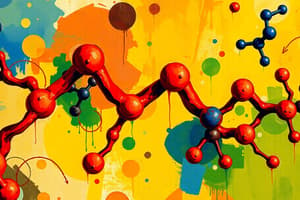Podcast
Questions and Answers
What are macromolecules composed of?
What are macromolecules composed of?
- Polysaccharides only
- Polymers bound together
- Monosaccharides only
- Monomers bound together (correct)
What is the primary function of carbohydrates?
What is the primary function of carbohydrates?
- Protein synthesis and cell signaling
- Energy storage and structural support (correct)
- Genetic information transmission
- Membrane function and steroid function
What type of molecules are hydrophobic?
What type of molecules are hydrophobic?
- Nucleic acids
- Proteins
- Lipids (correct)
- Carbohydrates
What are the monomers of proteins?
What are the monomers of proteins?
What is the function of nucleic acids?
What is the function of nucleic acids?
What are the polymers of nucleic acids?
What are the polymers of nucleic acids?
What is an example of a carbohydrate?
What is an example of a carbohydrate?
How many different amino acids are there?
How many different amino acids are there?
What is the primary function of lipids in the body?
What is the primary function of lipids in the body?
What is the characteristic of lipids that determines their behavior in water?
What is the characteristic of lipids that determines their behavior in water?
What is the polymer formed by the bonding of amino acids?
What is the polymer formed by the bonding of amino acids?
What is the monomer unit of carbohydrates?
What is the monomer unit of carbohydrates?
What is the function of proteins in cells?
What is the function of proteins in cells?
What is the term for the long chains of monosaccharides?
What is the term for the long chains of monosaccharides?
What are the four main categories of macromolecules?
What are the four main categories of macromolecules?
What is the term for the building blocks of nucleic acids?
What is the term for the building blocks of nucleic acids?
Flashcards are hidden until you start studying
Study Notes
Macromolecules
- Large structures that make up all living organisms
- Composed of polymers, which are formed by binding multiple monomers together
Types of Macromolecules
- Categorized into four main groups: carbohydrates, lipids, proteins, and nucleic acids
Carbohydrates
- Primary function: main fuel source and structural support for plants
- Monomers: monosaccharides (e.g., glucose)
- Polymers: polysaccharides (long chains of monosaccharides)
- Example: glucose, an energy source for the body that produces ATP
Lipids
- Variety of functions: energy storage, membrane formation, and steroid function
- No monomers or polymers
- Characteristics: hydrophobic (water-repelling)
- Composed of: fats, phospholipids, and steroids
- Fats: can be saturated or unsaturated
- Phospholipids: form cellular membrane with hydrophobic tails and hydrophilic heads
- Steroids: regulate sex hormones
Proteins
- Crucial for all cellular functions
- Monomers: amino acids (20 different types)
- Polymers: polypeptides (function dependent on amino acid folding)
- Folding types: primary, secondary, tertiary, quaternary
Nucleic Acids
- Primary function: transmit and express genetic information
- Monomers: nucleotides (nitrogenous bases: A, T, C, G, U)
- Polymers: polynucleotides (strands of DNA and RNA)
Macromolecules
- Large structures that make up all living organisms
- Composed of polymers, which are formed by binding multiple monomers together
Types of Macromolecules
- Categorized into four main groups: carbohydrates, lipids, proteins, and nucleic acids
Carbohydrates
- Primary function: main fuel source and structural support for plants
- Monomers: monosaccharides (e.g., glucose)
- Polymers: polysaccharides (long chains of monosaccharides)
- Example: glucose, an energy source for the body that produces ATP
Lipids
- Variety of functions: energy storage, membrane formation, and steroid function
- No monomers or polymers
- Characteristics: hydrophobic (water-repelling)
- Composed of: fats, phospholipids, and steroids
- Fats: can be saturated or unsaturated
- Phospholipids: form cellular membrane with hydrophobic tails and hydrophilic heads
- Steroids: regulate sex hormones
Proteins
- Crucial for all cellular functions
- Monomers: amino acids (20 different types)
- Polymers: polypeptides (function dependent on amino acid folding)
- Folding types: primary, secondary, tertiary, quaternary
Nucleic Acids
- Primary function: transmit and express genetic information
- Monomers: nucleotides (nitrogenous bases: A, T, C, G, U)
- Polymers: polynucleotides (strands of DNA and RNA)
Studying That Suits You
Use AI to generate personalized quizzes and flashcards to suit your learning preferences.




